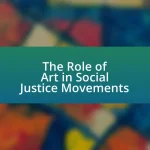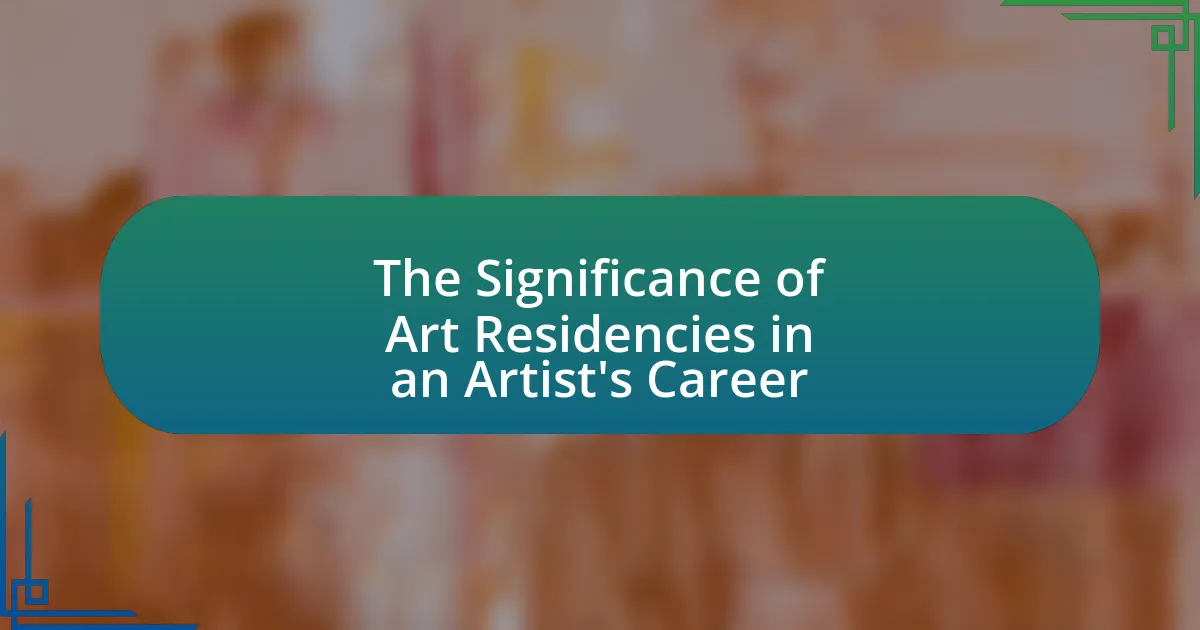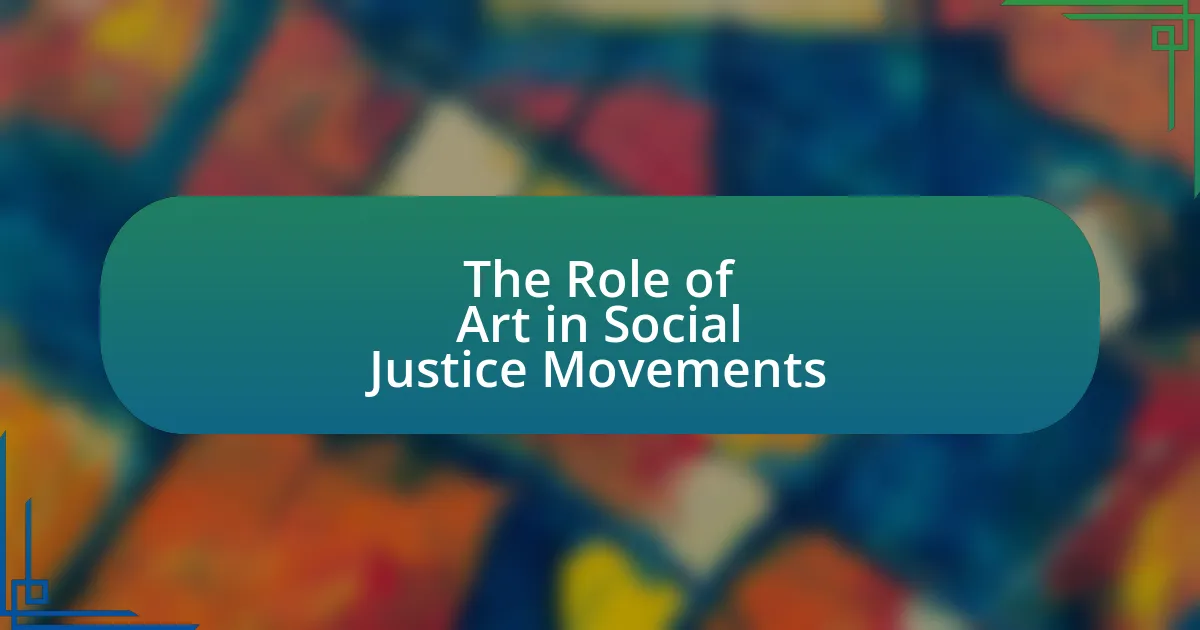The article “Women in Art: Celebrating Female Pioneers” examines the significant contributions of women to the art world, highlighting their unique perspectives and experiences that have enriched artistic expression. It discusses the historical barriers female artists faced, the impact of societal views on their work, and the importance of recognizing and celebrating female pioneers such as Frida Kahlo, Georgia O’Keeffe, and Artemisia Gentileschi. Additionally, the article explores contemporary initiatives aimed at promoting women in art, the influence of female artists on various movements, and the ongoing need for equitable representation in galleries and exhibitions. Through this analysis, the article underscores the essential role women have played in shaping art history and the importance of supporting their continued presence in the art community.
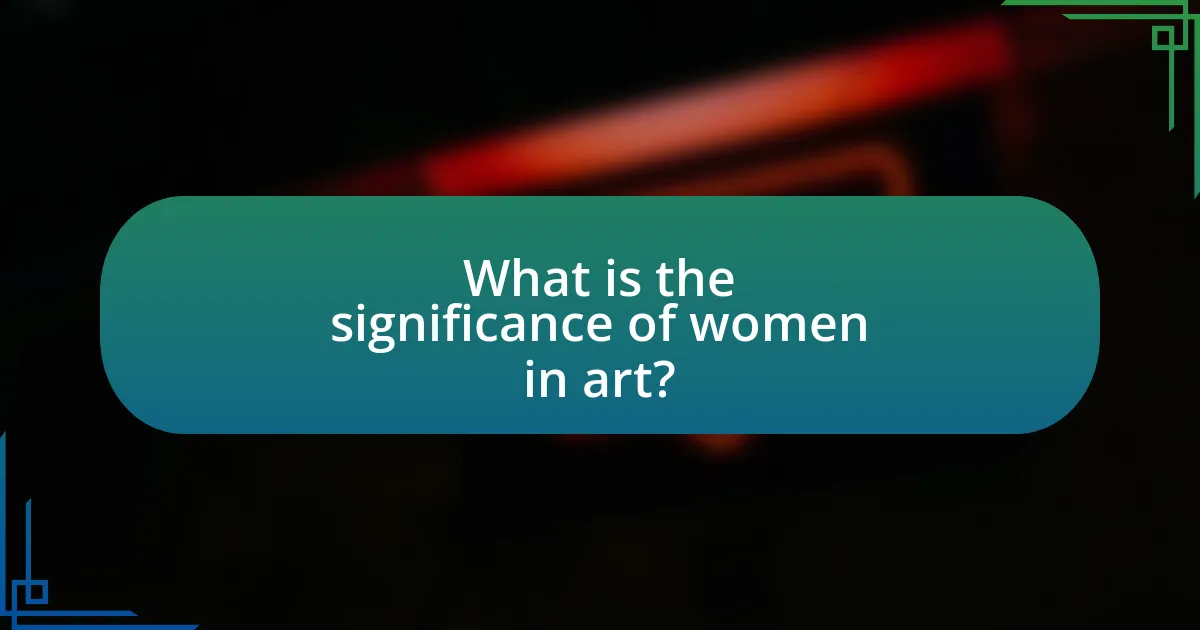
What is the significance of women in art?
Women play a crucial role in art by contributing unique perspectives and experiences that enrich the artistic landscape. Historically, female artists have challenged societal norms and redefined artistic expression, as seen in the works of pioneers like Frida Kahlo and Georgia O’Keeffe, who explored themes of identity, gender, and personal experience. Their contributions have not only influenced contemporary art but have also paved the way for future generations of women artists, leading to increased representation and recognition in the art world. According to a study by the National Museum of Women in the Arts, works by female artists are often undervalued, highlighting the ongoing need to celebrate and elevate women’s contributions to art.
How have women contributed to the art world historically?
Women have historically contributed to the art world by creating significant works across various mediums and movements, often challenging societal norms. For instance, artists like Artemisia Gentileschi in the 17th century broke barriers with her powerful depictions of women in biblical narratives, while Georgia O’Keeffe in the 20th century became a leading figure in American modernism, known for her distinctive flower paintings and desert landscapes. Additionally, the feminist art movement of the 1970s, led by artists such as Judy Chicago and Miriam Schapiro, sought to address gender inequality in the art world and promote women’s perspectives. These contributions not only enriched the artistic landscape but also paved the way for future generations of female artists, highlighting the essential role women have played in shaping art history.
What barriers did female artists face in different eras?
Female artists faced significant barriers across different eras, including societal restrictions, lack of access to education, and gender discrimination. In the Renaissance, women were often excluded from formal art training and limited to domestic roles, which hindered their artistic development. During the 19th century, the rise of the academic art system further marginalized female artists, as they were often denied admission to prestigious art schools and exhibitions. In the 20th century, despite gaining more opportunities, women still encountered challenges such as being undervalued in the art market and receiving less recognition than their male counterparts. These barriers have historically restricted female artists’ visibility and opportunities within the art world.
How did societal views on women influence their artistic expression?
Societal views on women significantly influenced their artistic expression by constraining themes, subjects, and mediums available to female artists. Historically, women were often relegated to domestic roles, which limited their access to formal art education and professional opportunities. For instance, during the 19th century, many women artists were expected to focus on still life and portraiture, reflecting societal expectations of femininity and domesticity. This is evident in the works of artists like Mary Cassatt, who often depicted intimate scenes of women and children, aligning with the prevailing notion of women’s roles in society. Additionally, societal perceptions of women as muses rather than creators led to a lack of recognition for their contributions, as seen in the art movements where male artists dominated the narrative. Thus, societal views shaped not only the content of women’s art but also their visibility and legacy within the art world.
Why is it important to celebrate female pioneers in art?
Celebrating female pioneers in art is important because it acknowledges their significant contributions and challenges the historical gender biases that have marginalized women’s roles in the art world. Female artists like Georgia O’Keeffe and Frida Kahlo broke barriers, influencing artistic movements and inspiring future generations. Recognizing their achievements not only promotes gender equality but also enriches the cultural narrative by showcasing diverse perspectives and experiences in art history. This celebration helps to correct the historical oversight of women’s contributions, as evidenced by the fact that only 3% of artworks in major museums are by women, highlighting the need for greater visibility and representation.
What impact do female artists have on contemporary art?
Female artists significantly influence contemporary art by diversifying perspectives and challenging traditional narratives. Their contributions have led to the emergence of new artistic movements and styles, as seen in the works of artists like Yayoi Kusama and Kara Walker, who explore themes of identity, gender, and race. Research indicates that exhibitions featuring female artists have increased visibility and representation in galleries and museums, with the 2019 Venice Biennale showcasing a record number of female participants. This shift not only enriches the art world but also inspires future generations of artists, fostering a more inclusive and equitable environment in contemporary art.
How does recognizing female artists change the narrative of art history?
Recognizing female artists fundamentally alters the narrative of art history by highlighting their contributions and challenging the male-dominated perspectives that have historically prevailed. This shift allows for a more inclusive understanding of artistic movements and cultural contexts, as evidenced by the increasing acknowledgment of artists like Artemisia Gentileschi and Georgia O’Keeffe, whose works have been re-evaluated and celebrated in recent exhibitions and scholarship. Studies, such as those conducted by the National Museum of Women in the Arts, reveal that female artists have often been overlooked despite their significant impact on art, thus recognizing them not only enriches the historical narrative but also inspires future generations of artists.
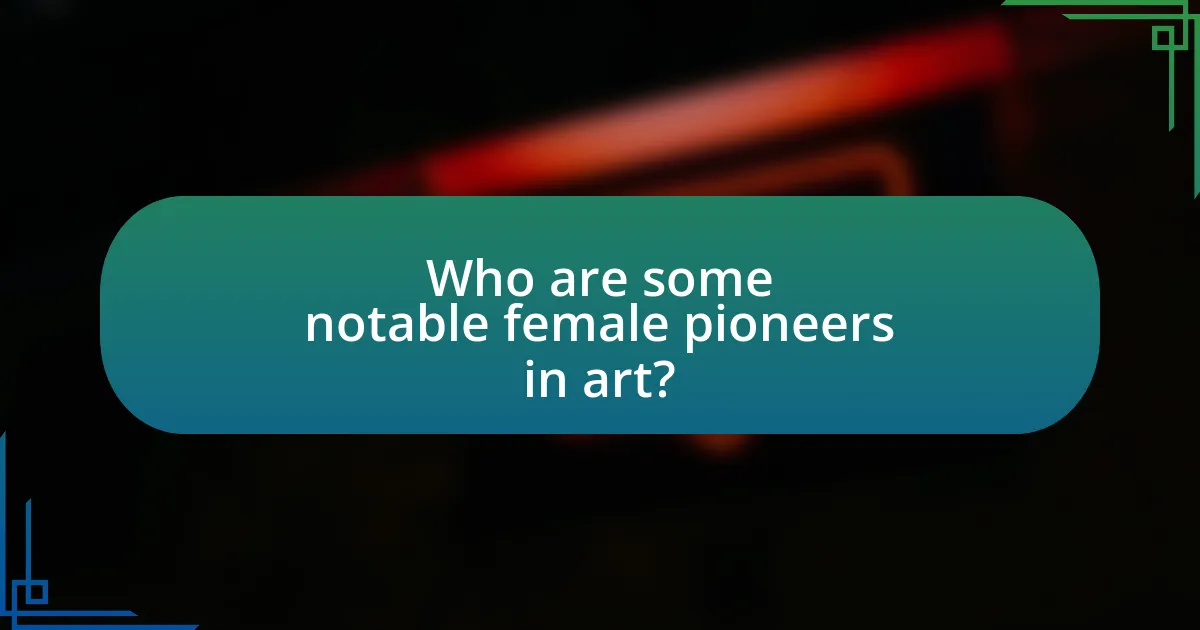
Who are some notable female pioneers in art?
Notable female pioneers in art include Artemisia Gentileschi, Georgia O’Keeffe, and Frida Kahlo. Artemisia Gentileschi, active in the 17th century, is recognized for her powerful depictions of women from biblical and mythological stories, breaking gender norms of her time. Georgia O’Keeffe, a key figure in American modernism, is celebrated for her large-scale flower paintings and desert landscapes, which challenged traditional representations of nature. Frida Kahlo, known for her deeply personal and symbolic self-portraits, explored themes of identity, postcolonialism, and gender, making her a significant figure in both art and feminist discourse. Each of these artists made substantial contributions to their respective movements and continues to influence contemporary art.
What are the contributions of specific female artists throughout history?
Female artists have made significant contributions throughout history, shaping various art movements and influencing cultural narratives. For instance, Artemisia Gentileschi, a Baroque painter, is renowned for her powerful depictions of women from biblical and mythological stories, challenging the male-dominated art world of the 17th century. Georgia O’Keeffe, a modernist painter, is celebrated for her large-scale flower paintings and desert landscapes, which redefined American art and emphasized the beauty of natural forms. Frida Kahlo, a Mexican painter, is known for her deeply personal and symbolic self-portraits that explore identity, postcolonialism, and gender, making her an icon of feminism and cultural expression. These artists not only excelled in their craft but also paved the way for future generations of women in the arts, demonstrating resilience and creativity in the face of societal constraints.
How did Frida Kahlo’s work reflect her personal experiences?
Frida Kahlo’s work profoundly reflected her personal experiences, particularly her physical suffering and emotional turmoil. Her paintings often depicted themes of pain, identity, and the female experience, drawing directly from her own life events, such as her struggles with polio, a severe bus accident, and tumultuous relationships, especially with Diego Rivera. For instance, in “The Broken Column,” Kahlo illustrated her spine as a shattered column, symbolizing her chronic pain and physical limitations. This direct representation of her suffering serves as a testament to how her art was a vehicle for expressing her inner struggles and personal narrative, making her work deeply autobiographical and resonant with themes of resilience and identity.
What innovations did Georgia O’Keeffe bring to modern art?
Georgia O’Keeffe brought significant innovations to modern art through her unique approach to abstraction and her focus on the natural world. She is renowned for her large-scale flower paintings, which emphasized form and color, transforming ordinary subjects into powerful visual statements. O’Keeffe’s work often featured bold colors and simplified shapes, challenging traditional representations and paving the way for future abstract artists. Her distinctive style not only redefined the boundaries of modern art but also highlighted the importance of female perspectives in a predominantly male art world, as evidenced by her prominent exhibitions and influence on subsequent generations of artists.
What movements were influenced by female artists?
Female artists have significantly influenced various movements, including the Feminist Art Movement, Surrealism, and Abstract Expressionism. The Feminist Art Movement emerged in the 1970s, driven by artists like Judy Chicago and Miriam Schapiro, who challenged traditional gender roles and sought to elevate women’s contributions to art. Surrealism, with figures such as Frida Kahlo and Meret Oppenheim, incorporated themes of identity and the subconscious, reshaping perceptions of femininity. Abstract Expressionism was also impacted by artists like Lee Krasner and Joan Mitchell, who brought a distinct female perspective to the movement, emphasizing emotional expression and individuality. These movements collectively demonstrate the profound impact of female artists on the evolution of contemporary art.
How did the feminist art movement reshape perceptions of women in art?
The feminist art movement reshaped perceptions of women in art by challenging traditional representations and advocating for women’s voices and experiences. This movement emerged in the late 1960s and 1970s, highlighting the underrepresentation of women artists and critiquing the male-dominated art world. Artists like Judy Chicago and Miriam Schapiro created works that celebrated female identity and addressed issues such as gender inequality and sexuality. Their exhibitions, such as “The Dinner Party,” showcased women’s contributions to art history and sparked discussions about the role of women in society. This shift in perception led to greater recognition of female artists and the inclusion of feminist themes in contemporary art, fundamentally altering how women are viewed within the art community.
What role did women play in the Surrealist movement?
Women played a significant role in the Surrealist movement, contributing as artists, writers, and muses. Prominent figures such as Leonora Carrington and Dorothea Tanning created influential works that challenged traditional gender roles and explored themes of identity and the subconscious. Additionally, women like André Breton’s partner, Nadja, inspired key Surrealist ideas and aesthetics. Their involvement not only enriched the movement but also highlighted the complexities of female experience in a male-dominated art world, as evidenced by the inclusion of women’s perspectives in Surrealist exhibitions and publications.
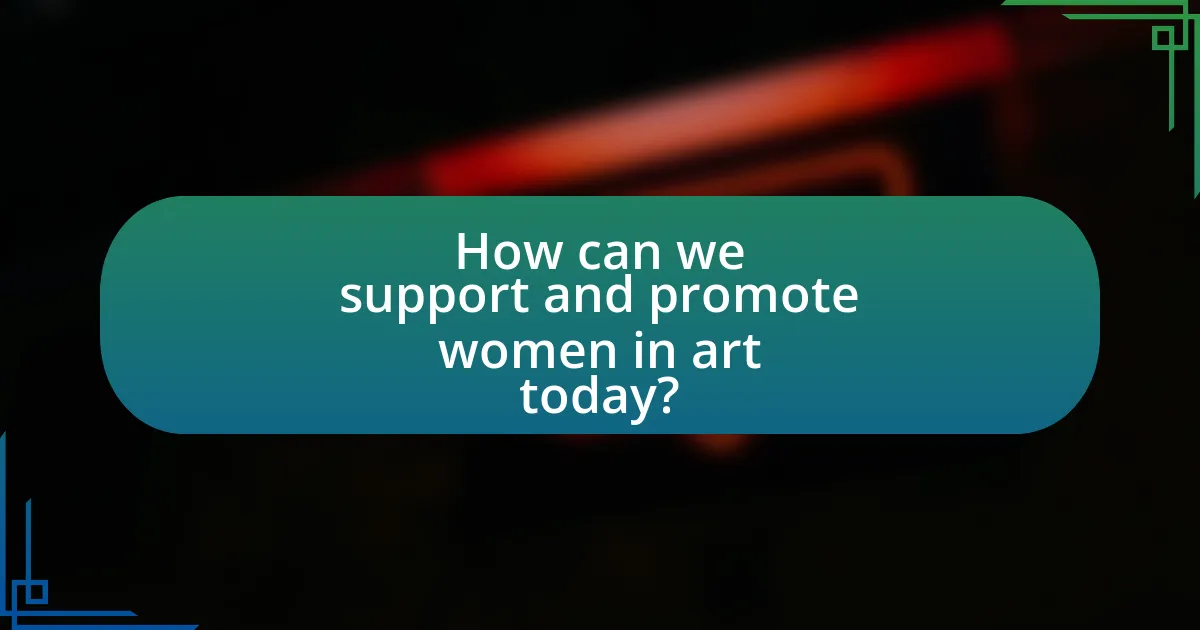
How can we support and promote women in art today?
To support and promote women in art today, institutions and organizations should prioritize equitable representation in exhibitions and funding opportunities. Research indicates that women artists receive significantly less exhibition space and funding compared to their male counterparts; for instance, a 2019 study by the National Museum of Women in the Arts found that only 11% of artists represented in major U.S. museums are women. By implementing policies that ensure gender parity in art shows and providing grants specifically for women artists, the art community can foster a more inclusive environment. Additionally, mentorship programs connecting established female artists with emerging talent can enhance visibility and career development for women in the field.
What initiatives exist to empower female artists in the contemporary art scene?
Numerous initiatives exist to empower female artists in the contemporary art scene, including organizations like the Guerrilla Girls, which advocate for gender equality in the art world through activism and public awareness campaigns. Additionally, the Women’s Caucus for Art provides networking opportunities, exhibitions, and educational programs specifically aimed at supporting women artists. The Artadia grant program also focuses on funding female artists, offering unrestricted financial support to help them advance their careers. These initiatives collectively aim to address the gender disparities in the art industry and promote the visibility and recognition of female artists.
How do art institutions and galleries support women artists?
Art institutions and galleries support women artists by providing exhibition opportunities, funding, and mentorship programs specifically designed to elevate their visibility and career development. For instance, many galleries curate shows that exclusively feature female artists, thereby increasing their representation in the art world. Additionally, organizations like the National Museum of Women in the Arts offer grants and fellowships aimed at supporting women artists financially. Research indicates that women artists often receive less exhibition space and funding compared to their male counterparts, highlighting the importance of these initiatives in addressing gender disparities in the art sector.
What role do art festivals play in promoting female talent?
Art festivals play a crucial role in promoting female talent by providing a platform for women artists to showcase their work and gain visibility in a predominantly male-dominated industry. These festivals often feature dedicated exhibitions, panels, and discussions that highlight the contributions of female artists, thereby fostering a supportive community and encouraging networking opportunities. For instance, events like the Venice Biennale have increasingly included female artists, with the 2019 edition featuring 58% women artists, demonstrating a shift towards greater representation. This visibility not only elevates individual artists but also challenges societal norms and inspires future generations of women in the arts.
What can individuals do to celebrate and uplift women in art?
Individuals can celebrate and uplift women in art by actively promoting and supporting female artists through various means. This includes attending exhibitions featuring their work, purchasing art from women artists, and sharing their art on social media platforms to increase visibility. Research indicates that female artists receive significantly less representation in galleries and museums, with only 11% of artworks in major U.S. museums created by women. By advocating for equal representation and inclusion in art spaces, individuals can help address this disparity and foster a more equitable art community.
How can art enthusiasts engage with and support female artists?
Art enthusiasts can engage with and support female artists by actively purchasing their work, attending exhibitions, and promoting their art through social media platforms. Purchasing artwork directly contributes to the financial stability of female artists, as statistics show that women artists often earn less than their male counterparts. Attending exhibitions not only provides visibility to female artists but also fosters community engagement and networking opportunities. Promoting their work on social media can amplify their reach, as platforms like Instagram have been shown to significantly increase exposure for artists, with female artists benefiting from a supportive online community.
What are some best practices for advocating for women in the art community?
Best practices for advocating for women in the art community include promoting female artists through exhibitions, providing mentorship opportunities, and ensuring equitable representation in galleries and museums. Research indicates that women artists are often underrepresented in major exhibitions; for instance, a 2019 study by the National Museum of Women in the Arts found that only 11% of artists in major exhibitions were women. By actively showcasing their work, organizations can help to elevate female voices in the art world. Additionally, creating mentorship programs can empower emerging female artists by connecting them with established professionals, fostering a supportive network that encourages growth and visibility. Lastly, advocating for policy changes that promote gender equity in art institutions can lead to more balanced representation and opportunities for women artists.


